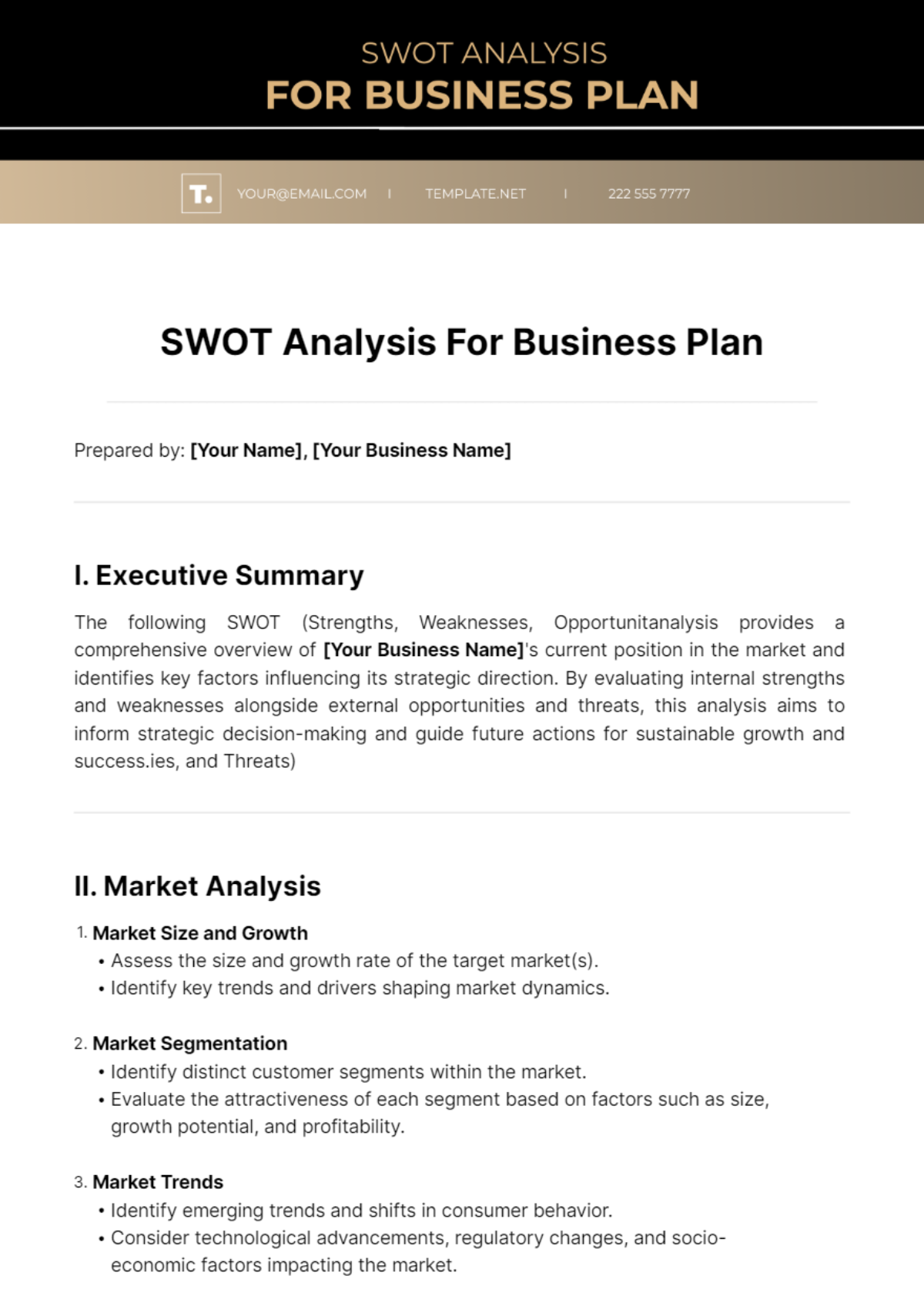SWOT Analysis For Business Plan
_____________________________________________________________________________________
Prepared by: [Your Name], [Your Business Name]
I. Executive Summary
The following SWOT (Strengths, Weaknesses, Opportunitanalysis provides a comprehensive overview of [Your Business Name]'s current position in the market and identifies key factors influencing its strategic direction. By evaluating internal strengths and weaknesses alongside external opportunities and threats, this analysis aims to inform strategic decision-making and guide future actions for sustainable growth and success.ies, and Threats)
II. Market Analysis
Market Size and Growth
Market Segmentation
Identify distinct customer segments within the market.
Evaluate the attractiveness of each segment based on factors such as size, growth potential, and profitability.
Market Trends
Identify emerging trends and shifts in consumer behavior.
Consider technological advancements, regulatory changes, and socio-economic factors impacting the market.
SWOT Analysis of the Market
Evaluate the strengths, weaknesses, opportunities, and threats within the market landscape.
Identify areas of opportunity and potential threats to market entry or expansion.
III. Customer Analysis
Customer Demographics
Profile the characteristics of your target customers (e.g., age, gender, income, location).
Identify primary and secondary customer segments.
Customer Needs and Preferences
Understand the needs, preferences, and pain points of your target customers.
Analyze customer feedback, surveys, and market research data.
Customer Behavior
Analyze purchasing behavior, decision-making processes, and factors influencing customer choices.
Identify key touchpoints and interactions throughout the customer journey.
Customer Satisfaction and Loyalty
IV. Competitive Analysis
Competitor Identification
Identify direct and indirect competitors operating in the market.
Assess their strengths, weaknesses, and market positioning.
Competitive Landscape
Analyze the competitive landscape in terms of market share, pricing strategies, and product/service offerings.
Identify competitive advantages and areas of differentiation.
SWOT Analysis of Competitors
Evaluate the strengths, weaknesses, opportunities, and threats of key competitors.
Identify areas where your business can gain a competitive edge.
Competitive Strategies
V. Strengths
Unique Value Proposition (UVP)
Identify what sets your business apart from competitors.
Highlight any proprietary technology, patents, or processes.
Strong Brand Recognition
Assess the strength of your brand in the market.
Consider brand reputation, customer loyalty, and brand awareness.
Skilled Workforce
Financial Stability
Analyze your financial resources, revenue streams, and cash flow.
Consider if you have sufficient capital to support business growth and withstand market fluctuations.
Strategic Partnerships
Identify any alliances or partnerships that provide access to resources, distribution channels, or new markets.
Assess the value and strength of these relationships.
VI. Weaknesses
Limited Market Presence
Resource Constraints
Identify any limitations in terms of financial resources, manpower, or technology.
Assess how these constraints may hinder business operations or growth.
Dependency on Key Personnel
Product or Service Limitations
Assess any shortcomings or gaps in your offerings.
Consider customer feedback, product/service reviews, and areas for improvement.
Operational Inefficiencies
Identify areas where your business processes can be optimized.
Consider factors such as production bottlenecks, supply chain issues, or outdated technology.
VII. Opportunities
Market Expansion
Identify untapped markets or niche segments with growth potential.
Consider geographic expansion, demographic shifts, or emerging trends.
Technological Advancements
Explore how advancements in technology can enhance your products, services, or operations.
Consider opportunities presented by AI, IoT, blockchain, etc.
Strategic Alliances and Partnerships
Explore potential collaborations with complementary businesses.
Consider joint ventures, co-branding opportunities, or distribution partnerships.
Changing Consumer Preferences
Regulatory Changes
VIII. Threats
Intense Competition
Assess the competitive landscape and potential threats from new entrants or established rivals.
Consider pricing pressures, product differentiation, or market saturation.
Economic Downturns
Evaluate the impact of economic fluctuations on your business.
Consider how you can mitigate risks associated with recessions, inflation, or currency fluctuations.
Technological Disruption
Identify disruptive technologies or innovations that could render your products or services obsolete.
Consider how you can stay ahead of technological advancements and adapt your business model accordingly.
Supply Chain Disruptions
Assess vulnerabilities in your supply chain.
Consider risks such as raw material shortages, transportation disruptions, or supplier dependencies.
Legal and Regulatory Risks
Identify potential legal or regulatory challenges.
Consider risks related to intellectual property, data privacy, or industry-specific regulations.
IX. Conclusion
This SWOT analysis, supplemented by market, customer, and competitive analyses, provides a comprehensive framework for strategic planning and decision-making at [Your Business Name]. By leveraging strengths, addressing weaknesses, capitalizing on opportunities, and mitigating threats, [Your Business Name] can navigate the competitive landscape with confidence and pursue sustainable growth objectives. Regular review and adaptation of this analysis will ensure [Your Business Name] remains agile and responsive to evolving market dynamics.
_____________________________________________________________________________________
Analysis Templates @ Template.net






























